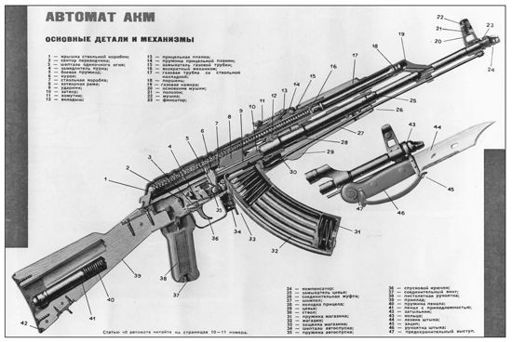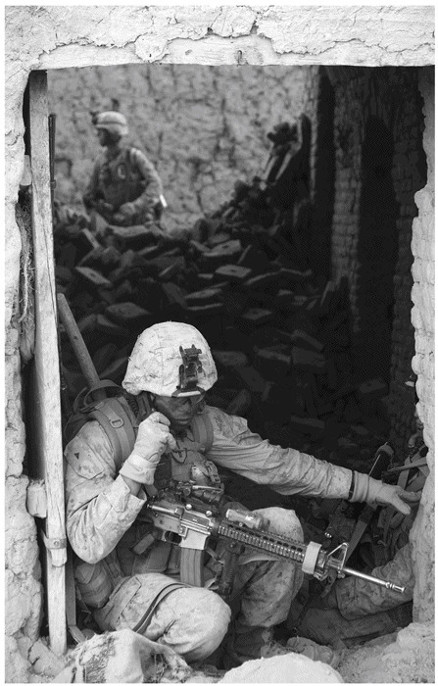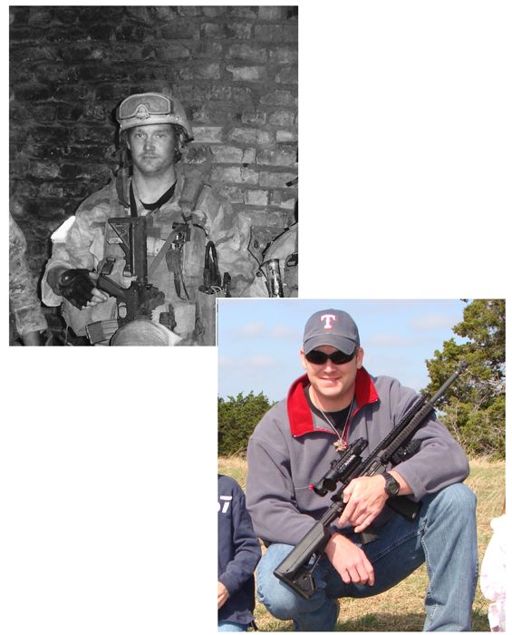American Gun: A History of the U.S. In Ten Firearms (32 page)
Read American Gun: A History of the U.S. In Ten Firearms Online
Authors: Chris Kyle,William Doyle
Tags: #History, #Non-Fiction


Above: the M4, a direct descendant of the M16. Below: the Russian AK47, the M16’s lifelong rival.
Colt’s Manufacturing Company
(top)

For Jeff, “Learning the history of that weapon was pretty cool.” We’d been shooting since we were kids so he was right at home when the drill instructor finally let them use the gun they’d been marching around with forever. “It was a piece of junk in Vietnam, but it was built up to what it is now. It’s impressive, and they keep making them better. Even in my first four years, they transitioned to A3. Then in Recon, we had the M4.”
His preferences depended on the job that had to be done. The shorter-barreled M4 was a better weapon for clearing a building; the smaller length meant it was easier to maneuver in tight quarters. It was also a little less trouble carrying. But both versions shot more or less the same. “I didn’t see a whole lot of difference in the effect of the rounds when it came to distances,” says Jeff. “And most of our action was pretty close up.”
Getting used to full auto took some practice, but after a few eight to ten-hour days of training, most of the men got to the point where they could squeeze off two or three rounds if they wanted to from the full auto version of the M4. That fire control gave them the advantage of both worlds—they could save ammo with a quick burst, and have full auto instantly if they needed it. But it was only something you could get with a lot of practice.
Where the first generation of M16s had twenty-round mags, thirty go in the boxes under today’s guns. But the improvement my brother felt was the most important over those earlier models were on the rails. They let him hang all manner of gear on them.
Back in World War I, battle rifles were naked, except for the bayonet and strap. The first M16s were pretty naked themselves, though a bayonet was designed to be attached to the tip. Soon, though, someone figured out you could slap a grenade launcher to the bottom of that sucker, and give the average infantry squad a lot more firepower. The 203 grenade launcher became very popular with squads needing a little more oomph in battle—and what rifle squad doesn’t?

U.S. Marines and an M16A4 in Afghanistan, 2009.
U.S. Marine Corps (photo by Cpl. Albert F. Hunt)
With the latest versions of the gun, you can put gear on the top as well as the bottom, thanks to the rails. Scopes and laser sights are the most common; bipods, vertical grips—it’s getting to the point where anything you can think up, someone has found a way to get it onto the gun. All that gear makes the gun heavier, taking away one of its advantages. On the other hand, its light weight to begin with makes the package lighter than it might have been.
Optics and laser sights are now pretty much necessities. Being able to fight well at night gives you an advantage over most if not all enemies. And while the M4 and M16 are not sniper weapons, scopes can help soldiers reach out and touch their enemy at a decent range.
Incidentally, I used a Marine M16 rifle in Fallujah, Iraq. It was a standard infantry rifle, but I got it in an unusual way—I traded a Marine for it.
How do you get a Marine to give up his rifle? Give him a bigger one.
In 2004, I was part of a SEAL sniper unit attached to the Marines as they worked to clear the city of insurgents. After our first few days in the city, the enemy started getting smart and avoiding areas where the snipers were working. Meanwhile, the Marines on the ground going into houses were taking all the risks. It was hard to stand up on a roof feeling useless while they were getting shot inside the buildings. So I offered one of the Marines who was providing security for my sniper post a deal he couldn’t refuse: Take my sniper rifle, I told him, and I’ll use your M16.
I don’t know that he got any kills with my gun, but I used his to shoot some Chechens who’d come to Iraq to help wipe out us infidels. The whole thing was a bit of a shock, for them and for me. We’d just breached the house and I stepped into the front room where they were gathered. I don’t know what I expected to see, but whatever it was, it wasn’t them. I looked at these white faces and blinked—they were the first white guys I saw on the enemy’s side of the fence since I’d been in the country.
They were still dazed from our entry. But that only lasted a second. They started to react, grabbing for guns. So did I. Full auto never felt so good.
The gun that I had traded the Marine was a Mk11, an automatic decked out in a style not unlike an M16. My brother Jeff used the same weapon when he was working as a spotter and secondary shooter on a two-man sniper team as a Marine. Carrying the gun meant he only had to hump one rifle into battle. Because it was a semi-automatic, the Mk11 gave him the ability to provide cover at close range. But it also had long-range accuracy. And the gun’s scope doubled as a spotting scope.
I liked the SEAL version of the gun myself for pretty much the same reasons. Mine didn’t have a collapsible stock, but that was a small tradeoff. The 7.62 × .51mm rounds meant more stopping power, less sweat on my side of the weapon.
The AR-15 family has its own sniper version in use by SEALs, the U.S. Navy Mk 12 Special Purpose Rifle. The rifle has a sixteen-inch barrel but other than that is very similar to an M4. It fires a 5.56 × 45mm round from a thirty-bullet magazine. While the gun could be selected for full auto, I never fired it that way. I suppose it would have been handy to have if the situation came up where I needed it, whether to get the enemy’s head down in a hurry, or to deal with a mass attack.
After the first wave of developers, other manufacturers like HK, Sig, you name it, began working on their own variations of the AR-15 design, knowing that the U.S. military wouldn’t adopt anything else. The process has resulted in a much better gun family. HK’s 416 is a phenomenal weapon, accurate and durable. Sig’s 516 is another excellent development of the original concept, burnished with touches from the Sig brain trust.
Because the weapon has been adapted and adopted by so many countries and large manufacturers, it’s opened the way for small companies to offer add-ons and improvements. That’s become especially big as civilian versions have been adapted by recreational shooters. To some, the civilian version of the AR15 is now a “Barbie Doll for guys”—the platform can be customized any way you want it. Vertical grips, sight systems, rail systems, trigger systems are now a big part of the market.
But customization has been important for one segment of weapons community that probably no one thought would need a high-powered rifle back in the late 1950s or early 1960s—law enforcement.
A series of shootouts in the late 1980s and 1990s convinced police departments they had to change the way they did things, and bring more firepower to the streets. One of the worst incidents occurred February 28, 1997, in North Hollywood, California. Larry Phillips Jr. and Emil Mătăsăreanu picked that day to rob the Bank of America in North Hollywood. It wasn’t a spur of the moment decision—the pair had been scouting the place for months. They had a number of violent crimes on their resume. They came prepared for their forced withdrawal with five rifles, a pistol, and over three thousand rounds of ammo. They were also wearing body armor.
Confronted by the police as they tried to escape, the pair easily outgunned the first officers on the scene, who had only 9mm handguns and a shotgun between them. While the criminals were cut off and trapped outside the bank, it took the police roughly forty-five minutes before they were finally able to kill them. In the meantime, eighteen officers were wounded out of the nearly three hundred involved.

Top: With my M4 on our first deployment in Iraq. Bottom: Hunting feral hogs in Texas with a favorite AR15.
The Kyle family
The two men’s rifles included an HK-91 with a drum magazine and AKMs. Their armor-piercing bullets were capable of slicing through the vests the police wore.
“It was a watershed,” says Mark Hanten, my SWAT commander friend. The shoot-out was studied by his and other police forces all across the country. Among the more obvious conclusions: the police needed to be better armed.
Automatic rifles were part of the solution. While SWAT teams were common by the 1990s, North Hollywood and incidents like it showed that the specialty units were not the only ones who need high-powered rifles. As Rich Emberlin, who’s worked both SWAT and high-level protection roles in the Dallas police department points out, the first guys on the scene are often the ones who have the best chance to contain a situation before it gets ugly.
I can attest to the fact that criminals are seriously armed these days. A while back, the Dallas police department allowed me to tag along when they served a warrant on some suspected bad guys. The weapons stash they had would have made a SEAL’s eyes water. In fact, it did—I couldn’t believe the range of handguns and rifles the criminals had massed. The confiscated weapons filled a large van.
Dallas has started a program to equip patrolmen with AR15 variants. Besides finding the money, one of their biggest problems is making sure that the officers have enough time to train—which means they have to worry about having enough officers to fill their patrol spots while they’re on the range. Out in San Diego, Mark’s department spent five thousand dollars on ammo alone when half the SWAT team trained with new AR15-style rifles.
About those new guns: I worked with Mark as he went about putting the new kits together. They’re Sig Sauer 516s with ten-inch barrels and some very nice optics. It is a great package for perimeter and containment work, as well as being compact enough for interior work. There were smiles all around the range when the team was done.
On the other hand, I don’t think anyone in the department will be sorry if they’re never used anywhere but the target range.
Whether they’re used in war or for keeping the peace, guns are just tools. And like any tool, the way they’re used reflects the society they’re part of. As times change, guns have evolved. If you don’t like guns, blame it on the society they’re part of.
